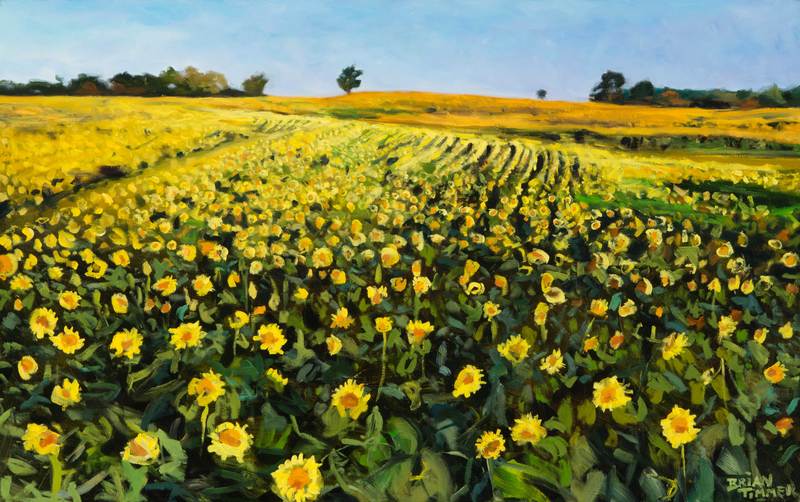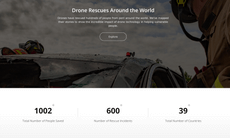Brian Timmer received his Bachelor of Fine Art degree in painting from Western Michigan University in 2003. Since then, Brian has been creating a diverse and expressive body of work. The styles in which he paints range from abstract expressionism to realistic landscapes and even large-scale indoor murals. His many commissioned projects can now be seen across the country.
For Brian, art is a vehicle for examining and expressing thoughts about inner and outer realities. For instance, in his abstract work, he explores the inner realm of things unseen. Themes in this type of work include human purpose and meaning, daily priorities, fears and motivations that shape our lives. In his outer, representational work, Brian strives to capture and celebrate the grandeur of the natural world. The goal is to let the world in all of its beauty and complexity speak for itself.
Ultimately, Brian believes that successful art is both powerful and mysterious. He believes that each brushstroke has the potential to surpass the mind and go straight to the heart. In this act, beautiful art has the ability to draw us to a hope that transcends our world. Over the last two years, he began incorporating a drone into his process, transforming the aerial photos and videos he captured into the source material for a series of paintings.
How did you get into drones?
I have always thought that drone technology was exciting. The idea that you could just shoot up into the sky and get views and footage that previously required expensive aircraft was amazing.
When I was ready to buy my first drone, my wife didn't like the idea of me dropping $1500. She asked if I would be willing to buy a "cheap" one for starters. While the $99 drone I chose was very difficult to fly, it gave me just enough of a taste that I knew I wanted something better.
One day, a friend insisted that I take his Phantom 3 home with me to use. He was confident that I could fly it without issues. I was impressed with how well it worked and how much easier it was to use than my "starter" drone.
When it came time to buy a nicer drone, I went with a 3DR Solo. The next drone I purchased was a DJI Phantom 4. When the Pro version was released just eight months later, I chose to upgrade to the Phantom 4 Pro. I wanted the better camera and obstacle avoidance functions.

What did your friends and family think at first? How did you wife react when you decided to drop $1500 on a Phantom?
My friends sort of rolled their eyes when they heard I had been through four different drones in less than three years. I told my wife it was a tool for making art, but she didn't really believe me at first. She thought it was just a fancy tech toy I wanted. But since I now use the drone regularly for my art business, my wife is comfortable with it. Not only do I use it for beautiful photos and video, I've also used it for my own personal advertisements and even been hired for specific video needs.
How has drone flying changed your career as a painter? Is this your main subject material
As a fine art painter, I knew that having a good drone would enhance my art. Most people enjoy dramatic elevated views of the world I think this is why so many people enjoy hiking mountains. The subtle contrast on the horizon and atmospheric colors can be breathtaking. I've always enjoyed the glowing shades of blue far off in the distance and the varying textures of the land.
My drone is one tool among many that I use as an artist. I paint in a range of styles, sometimes representational and sometimes abstract. With my drone, I can paint unique views of cities and landscapes that allows me to offer something different as an artist.
How has your approach to painting from drone photos and video evolved over time? What have you left behind and where do you hope to go next in terms of technique?
The main thing that has changed is my awareness of just how many perspectives are available with the drone. It can take a significant amount of research to get the best shot. It is important to know the land, the architecture and sources of light. Getting this information sometimes requires multiple fights on different days. I pay more attention to the angle of the sun and the weather conditions than I used to. I also try to take as much video as photos. By having high quality video, I can take stills for more scene selections and composition choices.
As a painter, I continue to try new things and be challenged. I'm always buying new brushes and trying to paint in slightly different ways. Since I'm expressive and energetic while I paint, I've learned that acrylic paint can work best for architecture. This allows me to paint quickly and leave a certain level of abstraction and texture in the paint. When I paint big skies and landscapes I almost always use oil paint. The slower dry time allows for softer rendering and gradations of color.
It's hard to know where I'm going to go "next" as a painter. I think that beauty is mysterious and creating art that brings satisfaction is a more intuitive than systematic process. My goal is simply to have life in the work and to bring the viewer enjoyment.

Do folks ever hassle you when you're flying? What do you think the mainstream perception of dronesâ is like these days?
I've always found flying in public places to bring both a mix of curiosity and fear. Most of the time, people look, point and talk about what they are seeing. Often, people come over to visit while I'm flying to see what I can see and ask questions. On one particular occasion, two women asked me if I would please take the drone down. They said my flying near them made them feel uncomfortable.
While I find this frustrating, I understand that the media is often the only information people have on drones, many associate them only with terrorism, war and spy-like activity. I try to use these situations to both listen and educate. Drone technology is so new, many people need to understand it's positive uses and how an artist like myself benefits from it. It especially helps when I can give them one of my business cards and invite them to my gallery to see the art I create.



